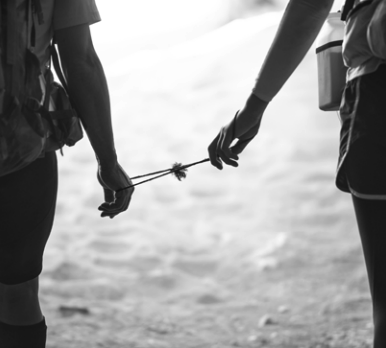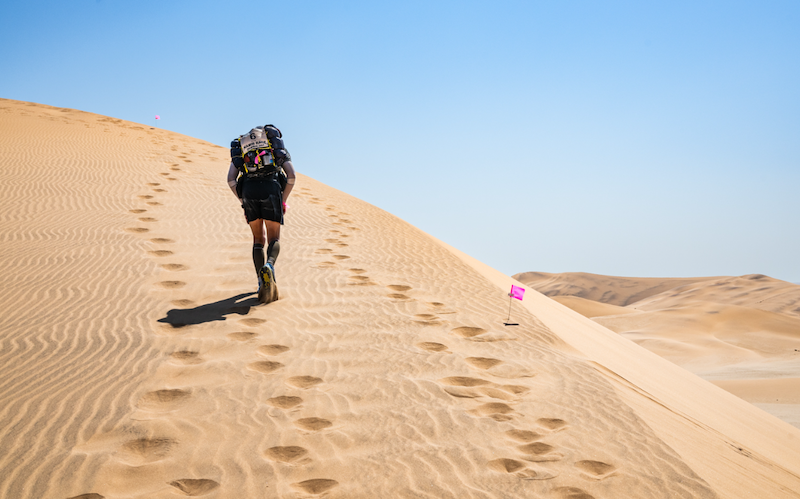My best friend Erin runs races.
I am not talking about races like the turkey trot I ran last fall right before sitting on the couch for 18 hours, or the three-legged one I ran at the company picnic. Or even the 12 mile trail run I did a few months ago.
She runs endurance races that are 250km over the course of six days. If you’re counting, that’s a marathon every day for four days in a row, a double marathon on the fifth day, and five miles on the 6th day as a cherry on top.
They’re races by a group called Racing the Planet, of which she’s completed three. They organize a series called the Four Deserts races, and she ran two of those – the Namibia Crossing through the Namib desert, and one through the driest desert in the world, the Atacama in Chile – plus one more in Patagonia.
She came in 64th out of 200 in Namibia. Next on her list is Gobi, which then makes her eligible to go to The Last Desert race, Antarctica. Absolutely wild.
And then some
Just to turn it up a notch, during Atacama, she guided a fellow racer – a blind man from Brazil – along the entire route, which meant that they were connected at the wrist with an 18-inch long string for the entire time they were running together. Vladmi dos Santos, who is involved with Brazil’s Paralympic Committee, ran his third 4 Deserts race as Erin guided him on her first.

Why do people do this for fun?
Out here in the mountains we call it “Type 2 fun”. The kind that leaves you sore, sunburned, waterlogged, wiped out – and totally fulfilled.
“We decided early on that this race for us was not going to be about achieving a certain time or getting a certain place,” Erin tells Adventure World magazine. “It is about the struggle, the experience, the camp life… For me, it is soul nourishing. It is difficult mentally and physically, but it has been so rewarding.”
The 4 deserts race might be the most hardcore on earth
The 4 Deserts Ultramarathon Series is one of the most grueling endurance challenges on the planet. Organized by RacingThePlanet since 2002, it’s a set of four 250km (that’s 155 miles) self-supported footraces held in the planet’s most extreme environments:
- Atacama Crossing (Chile) – the driest desert on Earth
- Gobi March (Mongolia/China) – known for brutal winds and shifting terrain
- Namib Race (Namibia) – the oldest desert, famous for towering sand dunes
- The Last Desert (Antarctica) – freezing cold, windy as hell, and invitation-only
Each race takes place over 7 days, divided into 6 stages, with competitors carrying all their own food, gear, and supplies; except water and a tent spot provided by race organizers.
It’s an enormous and extreme challenge, testing mental toughness, physical endurance, and survival skills, and completing all four earns you the elite status of joining the “4 Deserts Club.” It’s not for the faint of heart, and she plans her trips and training at least a year in advance.
Training for an endurance race
How she does it? “Run, a lot.” She runs after work and on the weekends. We hike together with a pack of dogs, sweating in the Colorado sunshine and taking the steeps ’til we feel the burn.
But since we’re typical mountain folk, she doesn’t take it too seriously. Her endurance training regimen includes:
- Running, a lot. Hiking, a lot. Gardening, cooking, weights, and kettlebells.
- She has the benefit of living in high altitude near Aspen, Colorado, so she’s already training in a lower oxygen atmosphere.
- She uses a smart scale that tells her a whole bunch of body composition data.
- She links her sleep app to her scale data so it’s in one place and aims for at least 8 hours.
- She tracks her miles, and runs a LOT, but doesn’t limit herself or push herself to hit a certain number each week. “It depends on how my body is feeling.”
- She works on her mental state, bringing self awareness to her thought patterns and how she speaks to herself.
- She takes time for recovery, and trains for the pain by sitting for up to 15 minutes in the freezing cold snowmelt of the Roaring Fork River.
At that extreme, it’s definitely mental
We’ve heard Tom Brady talk about how visioning is the key to making perfect connections with his wide receivers. We’ve heard Kevin Garnett tell us that “ANYTHING IS POSSIBLE!” We watched in awe as Alex Honnold memorized every single hand hold on El Capitan before his free solo. We see article after article about how to train harder and smarter.
But the real driver might be how well you push through the pain, not how well you try to avoid it.
“A race that long, pain is inevitable,” Erin says. “Your best effort isn’t the same every day. Just have to show up using what tools you have and give it your best shot.”
As a former wildland firefighter, Erin knows how to haul a chainsaw up a mountainside in the heat of a forest fire. Enduring pain is part of the game for her.
“I’d keep a bag of chocolate covered almonds in my pocket and give myself just one every 20 minutes,” the absolute gem of a human being told me.
Finishing requires a good attitude because it’s gonna hurt
Says Erin:
“I literally crossed the finish lines because of a good attitude. I never once told myself I can’t do this or I am not a good runner or they’re better than me. Of COURSE they’re better than me, they are sponsored Olympic athletes from Spain. I’m just going to try, keep trying and never quit. Might be last, definitely not first, but I will be hospitalized before I get a DNF.”
Now that’s determination even during pain. It earned her the Sportsmanship award and Vlad agreed: “At the 4 Deserts, nobody is better than anyone.”

Endurance racer research
We’re grateful that organizations like Racing the Planet take the space, time, and medical consideration to allow for research that furthers the field of studying our bodies under extreme and exciting conditions.
Overseen by by Stanford’s Emergency Medicine Physician Dr. Grant Lipman and connected to the Wilderness Medicine Fellowship at Stanford, there is not much else out there that looks into the effects of endurance racing on our bodies in such an applied way.
In their 2020 report, “Pain Is Inevitable But Suffering Is Optional: Relationship of Pain Coping Strategies to Performance in Multistage Ultramarathon Runners”, researchers found that at the conclusion of every race, pretty much everyone felt some sort of pain. But those who couldn’t cope, had a much harder time finishing than those who trained for the pain:
“Although increased pain intensity and pain interference was found in all multistage ultramarathon runners, successful event completion was significantly associated with less maladaptive pain coping. Training in coping with pain may be a beneficial part of ultramarathon preparation.”
- In this context, maladaptive measures basically means, the person felt the pain was so much that they wanted to stop. Focusing on it, they “felt defeated by their pain.”
- Those who finished, however, generally scored their optimism about their pain higher: It was a challenge rather than an obstacle. This is adaptive measures with environmental awareness.
The data brings confidence
“The data tells me that I’m on track,” Erin says. “I don’t necessarily make huge adjustments to my routine or diet… But it brings a ton more confidence knowing my body is ready, versus guessing.”
Whether you choose to micro-adjust your macros or just “go runnin’,” the distance and difficulty depends entirely on how well you can bear it.
Erin explains how she can not only bear it, but enjoy it:
“I do these hard things because I love the feeling of almost being done. The last two miles are my favorite. When you hurt the most, want to stop so badly, and you have to dig deep in your resilience reserves to find the energy to finish with your best effort. It only matters to you. I like it because we survive on hope and finish with our own level of integrity.”
The only way is through
Tom Brady was supposed to retire. Instead, he picked up and went double-or-still-five-rings and won another one. He asks himself an important question in 2020 that now feels like foreshadowing:
“The only way is through. If I don’t go for it, I’ll never know what I could have accomplished. Wanting to do something is different from actually doing it. If I stood at the bottom of a mountain, and told myself I could scale the highest peak, but then didn’t do anything about it, what’s the point of that?
I’m trying to do things that have never been done in my sport. That’s actually fun for me, too, because I know I can do them. When a team gives you the opportunity to do those things with them, well … if not with them, then who?
At some point, you have to throw your whole body into what you’re doing. You have to say, Let’s ride. Let’s see what we got.”
Are you pushing toward something that feels like a marathon a day for five days straight? Practice putting yourself to the test and sitting with the discomfort, so you can hold it for as long as it takes to win on your terms.
Leave a Reply